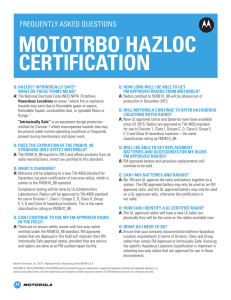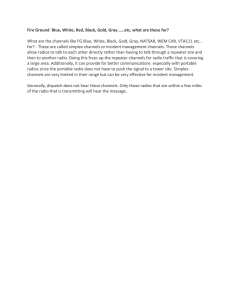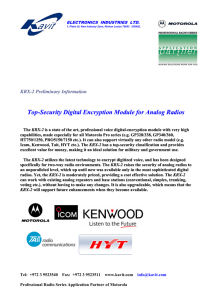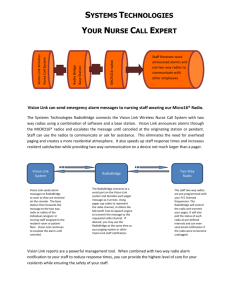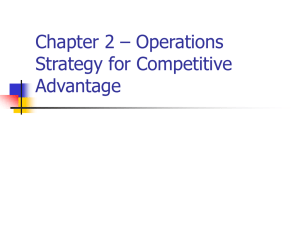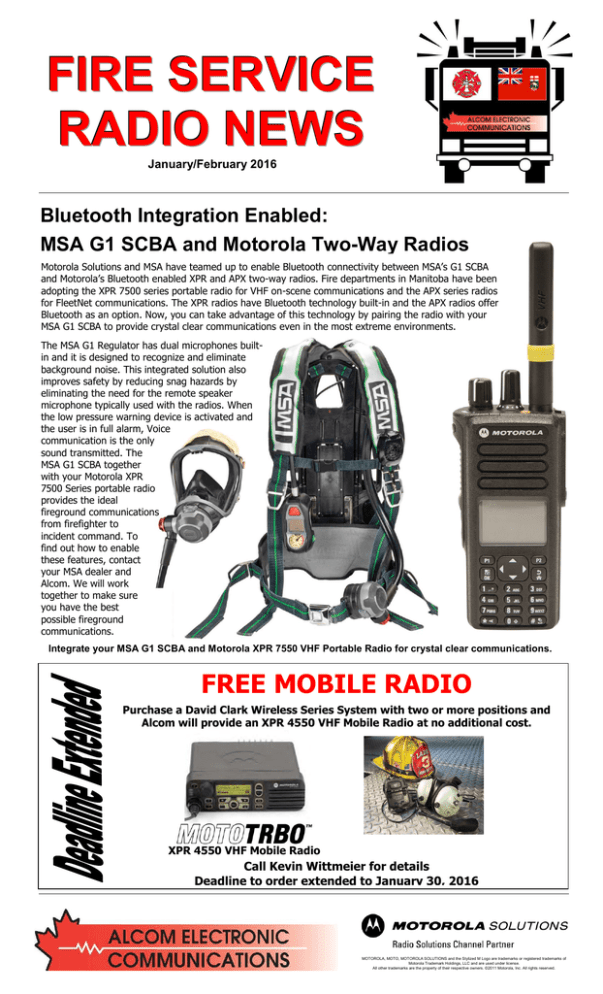
FIRE SERVICE
RADIO NEWS
January/February 2016
Bluetooth Integration Enabled:
MSA G1 SCBA and Motorola Two-Way Radios
Motorola Solutions and MSA have teamed up to enable Bluetooth connectivity between MSA’s G1 SCBA
Now
in Bluetooth
Service
FireFireDepartment
and Motorola’s
enabledat
XPR Dauphin
and APX two-way radios.
departments in Manitoba have been
adopting the XPR 7500 series portable radio for VHF on-scene communications and the APX series radios
for FleetNet communications. The XPR radios have Bluetooth technology built-in and the APX radios offer
Bluetooth as an option. Now, you can take advantage of this technology by pairing the radio with your
MSA G1 SCBA to provide crystal clear communications even in the most extreme environments.
The MSA G1 Regulator has dual microphones builtin and it is designed to recognize and eliminate
background noise. This integrated solution also
improves safety by reducing snag hazards by
eliminating the need for the remote speaker
microphone typically used with the radios. When
the low pressure warning device is activated and
the user is in full alarm, Voice
communication is the only
sound transmitted. The
MSA G1 SCBA together
with your Motorola XPR
7500 Series portable radio
provides the ideal
fireground communications
from firefighter to
incident command. To
find out how to enable
these features, contact
your MSA dealer and
Alcom. We will work
together to make sure
you have the best
possible fireground
communications.
Integrate your MSA G1 SCBA and Motorola XPR 7550 VHF Portable Radio for crystal clear communications.
FREE MOBILE RADIO
Purchase a David Clark Wireless Series System with two or more positions and
Alcom will provide an XPR 4550 VHF Mobile Radio at no additional cost.
XPR 4550 VHF Mobile Radio
Call Kevin Wittmeier for details
Deadline to order extended to January 30, 2016
ma
MOTOROLA, MOTO, MOTOROLA SOLUTIONS and the Stylized M Logo are trademarks or registered trademarks of
Motorola Trademark Holdings, LLC and are used under license.
All other trademarks are the property of their respective owners. ©2011 Motorola, Inc. All rights reserved.
FIRE SERVICE
RADIO NEWS
January/February 2016
Operating Radios in Hazardous Locations
HAZLOC CLASSIFICATION
HAZLOC CERTIFICATION TRANSITION
Hazardous locations (Hazloc) are defined as areas "where
fire or explosion hazards may exist due to flammable
gases or vapors, flammable liquids, combustible dust, or
ignitable fibers or flyings." Hazardous locations are found
in many industries, including fuel storage facilities,
chemical plants, grain elevators, and plastics processing.
The entire two-way radio industry is transitioning to the
new TIA-4950 standard for Hazardous Location
certification of two-way radios. All new Intrinsically Safe
Motorola radios will be certified by Underwriter
Laboratories (UL).
When electrical equipment is used in a hazardous
atmosphere there is the risk that electrical sparks or
abnormally high temperatures within device components
could ignite flammable or explosive substances in the
surrounding air. You face the risk of igniting flammable or
explosive substances during rescue operations at
hazardous locations like chemical spills, in grain elevators
and feed mills, and in proximity of gas leaks. In these
environments you need to use equipment with Hazloc
certification to reduce the risk of ignition.
Many fire departments in Manitoba are using portable
radios that have been certified intrinsically safe for use in
hazardous environments under the Factory Mutual
standard FM3610_88. These radios will continue to
maintain their FM Intrinsically Safe approval status,
provided they are used with the proper FM approved
batteries and any service and repairs are done at an FM
audited repair facility.
The hazardous location classifications are the same for
both the old FM standard and the new TIA standard (see
chart below).
HERE IS WHAT YOU NEED TO KNOW:
1) FM and UL approve the radio and battery together as a system. The FM approved battery may only be used on
an FM approved radio, and the UL approved battery may only be used on a UL approved radio, otherwise the
certification is not valid. However, you can operate with both FM and UL approved radios in your fleet.
2) The labels on the back of your radios will tell you which standard applies to your radio. See the chart above.
3) FM approved radios/batteries will have a green dot on the bottom. UL approved radios/batteries will have a
white dot on the bottom. Make sure the dots match when putting a battery on your intrinsically safe radio.
4) When you order new batteries,make sure you order the certified battery that matches your radio.
a) If your radio is an XPR 6000 Series FM approved radio, order battery model #PMNN4069A
b) If your radio is an XPR 7000 Series FM approved radio, order battery model #NNTN8129AR
c) If your radio is an XPR 7000 Series UL approved radio, order battery model #NNTN8560A
5) FM approved batteries will continue to be available for your older model radios. Call Alcom to find out which
battery is right for your radio.
6) The Minitor VI pager, when ordered as Intrinsically Safe, comes with the UL standard certification. The UL
approved replacement battery is model #PMNN4438A
7) The Minitor V pager came standard with FM certification. The replacement battery is model #RLN5707A
#12 – 846 Marion Street Winnipeg, MB., R2J 0K4
204-237-9099
www.alcom.ca

